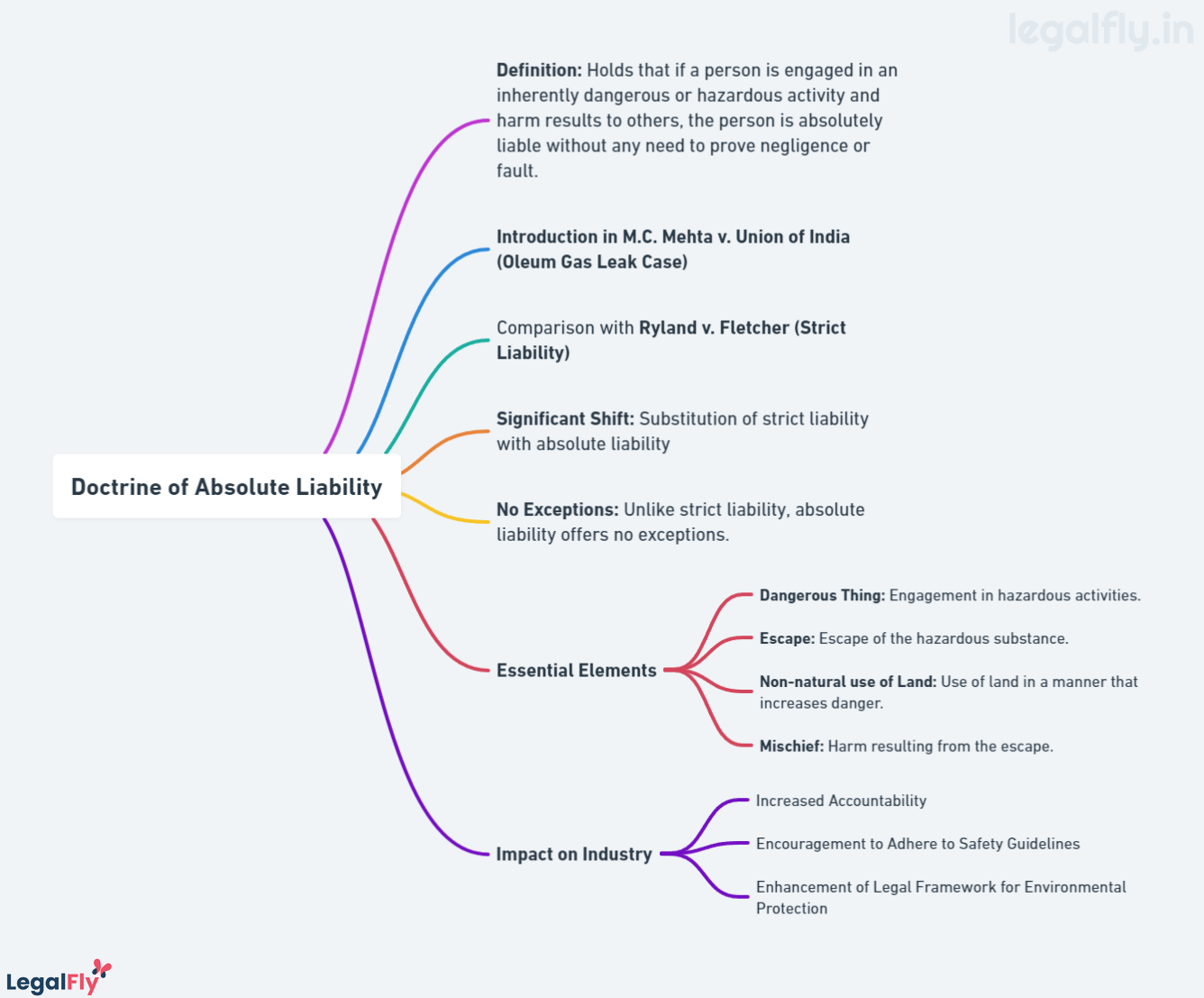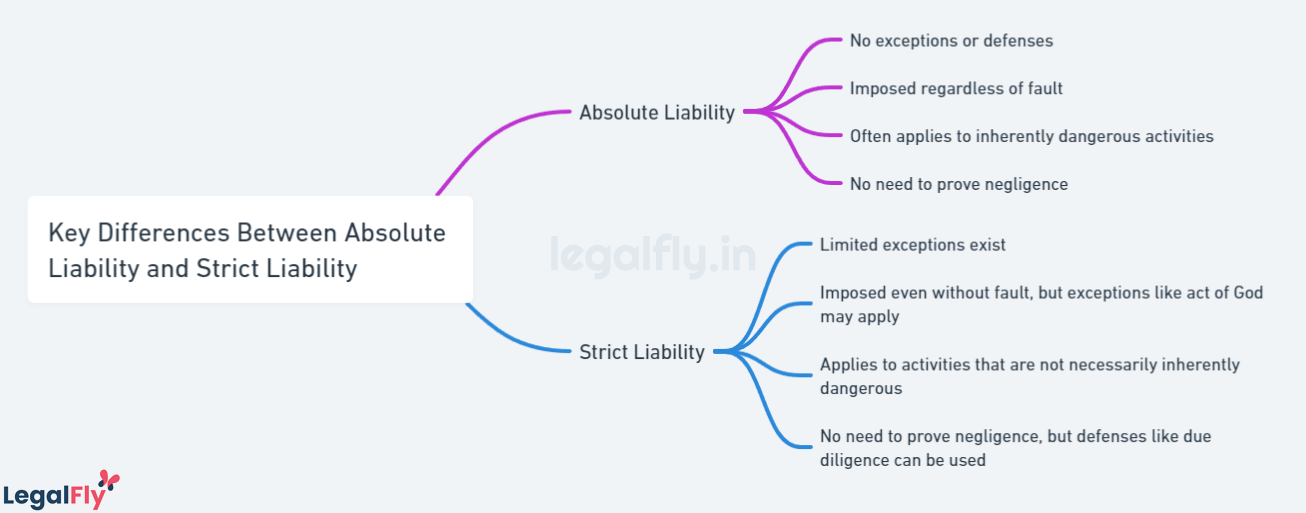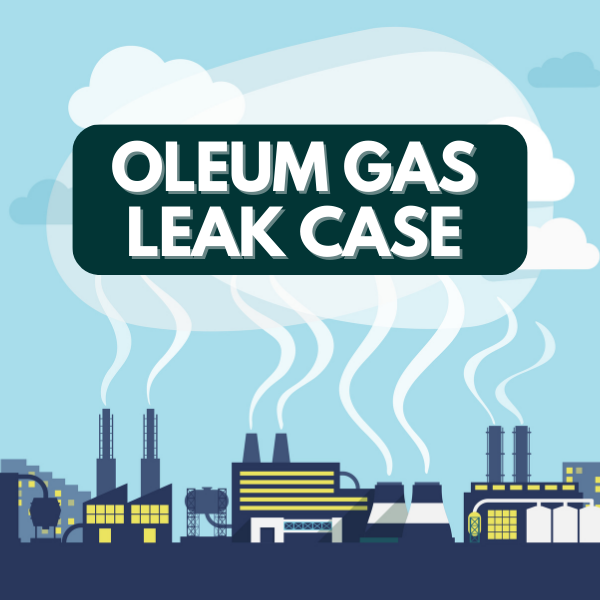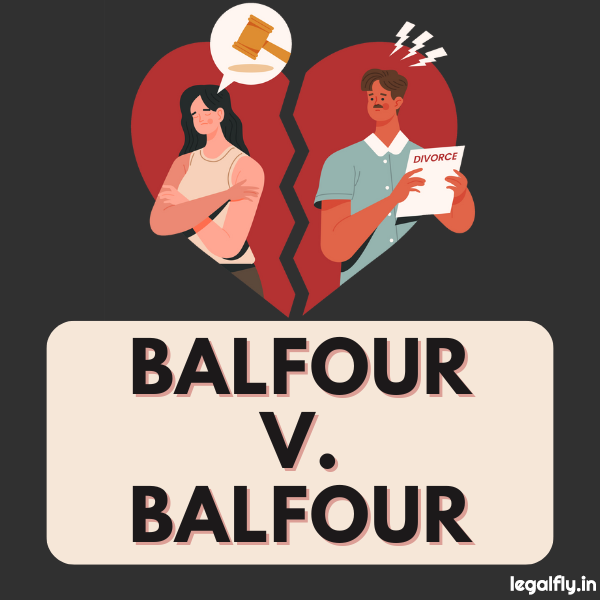Table of Contents
Understanding Absolute Liability
Absolute liability is a legal doctrine under tort law where liability is placed on the defendant without the need to prove fault or negligence. Unlike other standards like strict liability or negligence, the Plaintiff does not need to establish that the defendant failed to take reasonable care or was negligent in any way.
Under absolute liability, the defendant is held liable for damages caused by their actions, regardless of efforts taken to prevent any harm. Liability is attached by virtue of the Act rather than a lack of care.
The rationale behind absolute liability is that certain acts or activities are so hazardous that they should render parties automatically liable for any resultant damage. It aims to protect the public interest by compensating victims and deterring reckless behavior rather than basing liability on notions of moral blameworthiness.

Absolute liability differs from strict liability, where defendants can sometimes avoid liability by proving that all reasonable care was taken and the incident could not have been prevented. Under absolute liability, even reasonable care and precautions are not a defense if damage was still caused.
Exploring the Principle of Absolute Liability
The principle of absolute liability emerged in India through the landmark case of M.C. Mehta v. Union of India (1987) 1 SCC 395. This case involved the oleum gas leak from Shriram Foods and Fertilizer Industries in Delhi in 1985, which resulted in enormous damage.
The Supreme Court felt that the rule of strict liability, as established in the Rylands v Fletcher case, was insufficient to cover the magnitude of damage caused by modern industrial activities. As a result, it evolved the more stringent principle of absolute liability.
Absolute liability makes the defendant liable even if the damage is not foreseeable and is caused without any fault or negligence. The only defense allowed is an act of God or the Plaintiff’s own fault. This principle embodies the legal philosophy that enterprises engaged in hazardous activities should bear the cost of any harm caused, even without fault.
The rationale is that such enterprises benefit from these activities and must pay for any associated risks. It upholds the “polluter pays” principle and incentivizes safety and accountability among industries dealing with hazardous substances. Absolute liability goes beyond fault-based liability, creating a no-fault liability regime for enterprises. This showcases the evolution of tort law principles to balance individual interests with social welfare.
Essentials and Application of Absolute Liability
The principle of absolute liability is applied to activities that are considered inherently hazardous or dangerous. For absolute liability to be established, the Plaintiff only needs to prove that:
- The defendant was engaged in a hazardous or inherently dangerous activity
- The activity resulted in the release of a hazardous substance
- The hazardous substance caused damages
Unlike strict liability, there is no need to establish escape, non-natural, or special use under absolute liability. The defendant is liable irrespective of whether they took reasonable care or not.
The burden of proof lies entirely on the Plaintiff. They only need to show that the defendant’s hazardous activity caused the damage. Once established, the defendant is absolutely liable, regardless of any exceptions or absence of negligence or intent.
Absolute liability is applicable in situations involving hazardous industries, defective products, toxic waste disposal, accidents caused by motor vehicles, etc. It ensures enterprises or individuals undertaking risky activities take utmost safety precautions and that consumers/people are protected.
Key Differences Between Absolute Liability and Strict Liability

Strict liability and absolute liability are related legal concepts that deal with liability for damages caused without fault or negligence. However, there are some key differences between the two:
| Aspect | Strict Liability | Absolute Liability |
|---|---|---|
| Basis of Liability | Arises from the inherent risk or danger of an activity. Liability is attached to the activity itself, not the person’s fault. | Liability is attached simply because harm has occurred and is attributable to the defendant’s actions, regardless of care or precautions taken. |
| Defenses Available | – Plaintiff’s voluntary assumption of risk – Plaintiff’s contributory negligence – Act of God or vis major | No defenses available. Liability is absolute, even if precautions were taken and due diligence was followed. |
| Burden of Proof | Plaintiff must prove damages were caused by defendant’s activities involving special risks. | Plaintiff must establish that the defendant’s activities or materials caused the damages. No proof of negligence or fault is required. |
| Application Scope | Applied when an activity is abnormally dangerous or inherently hazardous. The escape or release of the hazardous substance is essential. | Applies to ultrahazardous activities posing severe risk, even with utmost care. Applicable even if the substance does not escape the premises. |
| Responsibility | Undertaken by the person carrying out the activity. | The whole enterprise is responsible. |
| Damages | Permits damages only for personal injury and property damage. | Allows for more comprehensive claims for damages. |
| Legal Precedent | Evolved from the precedent Rylands v Fletcher (1868), which established the principle of strict liability for escape of hazardous materials. | Established through the MC Mehta vs Union Of India (1987) case, also known as the Oleum Gas Leak case, which introduced absolute liability in India after the Bhopal Gas Tragedy. |
| Defensive Measures | Allows certain statutory defenses like consent of the Plaintiff, Act of God, Act of a third party, etc. | Does not permit any defense, making the enterprise automatically liable. |
| Notable Case Laws | Nichols v Marsland (1876): Recognized exceptions to strict liability such as natural use of land and act of God. | Indian Council for Enviro-Legal Action vs Union of India (1996): Reinforced the application of absolute liability for environmental harm without exceptions. |
In summary, strict liability is a fault-based doctrine that does not consider intent or negligence. Absolute liability goes a step further by completely eliminating any defense for the liable party. While strict liability is commonly applied in tort cases internationally, absolute liability is a uniquely Indian concept adopted to assign accountability for abnormally dangerous industrial activities.
Key Concepts in Strict Liability and Absolute Liability
Examining the Doctrine of Strict Liability
The doctrine of strict liability in tort law means that the defendant can be held liable for the Plaintiff’s loss caused by the defendant’s conduct, irrespective of the presence or absence of fault like intention or negligence. Under strict liability, the Plaintiff must only prove that the defendant’s conduct caused the loss to claim damages.
The origins of strict liability lie in the English case of Rylands v. Fletcher (1868), which established that a person who keeps hazardous substances on their land would be liable for any damage caused if the substances escaped. This departed from previous requirements to prove negligence and established strict liability for hazardous activities.
Strict liability differs from negligence-based liability in tort law. Under negligence, the defendant must have breached a duty of care owed to the Plaintiff, and damages must have been reasonably foreseeable. But under strict liability, the defendant is liable irrespective of reasonable care or foreseeability of damages. The key factor is whether the defendant’s conduct caused harm.
Application of Absolute Liability in the Indian Legal System
The application of absolute liability in the Indian legal system has evolved through legislative provisions, judicial decisions, and regulatory frameworks over the years.
The concept of absolute liability first emerged in India with the landmark case of M.C. Mehta v. Union of India. In this case, oleum gas leaked from one of Shriram Foods and Fertilizers Industries units in Delhi, leading to severe damage. The Supreme Court observed that an enterprise engaged in hazardous activities owes an absolute duty to the community. It laid down the rule of absolute liability and made the enterprise strictly and absolutely liable to compensate the victims regardless of any exceptions.
Following this judgment, the Public Liability Insurance Act was enacted in 1991, which mandated that all enterprises dealing with hazardous substances must take out insurance policies to provide immediate relief to victims and the environment damaged by accidents. The National Green Tribunal Act of 2010 further bolstered the regulatory framework by establishing special environmental courts to deal with Absolute Liability cases.
The rule of Absolute Liability has since been upheld and expanded to other contexts, like dumping hazardous waste, environmental pollution, etc, through subsequent judicial decisions. The Supreme Court has reinforced that any enterprise engaged in hazardous activities must bear absolute liability for any harm caused due to such activities. This principle ensures that victims are duly compensated and industries exercise abundant caution when handling hazardous substances.
Case Study: Oleum Gas Leak Incident
The oleum gas leak occurred on December 4, 1985, at the Shriram Foods and Fertiliser Industries plant in Delhi, resulting in leakage of oleum gas, which is hazardous to human health.
Facts of the case
- The oleum gas leaked from an open valve in a heat exchanger of the Shriram plant, spreading to the nearby areas and affecting many people.
- The gas caused suffocation, breathing difficulties, vomiting, and burning sensations in the eyes of many residents. One person died as a result.
- The leak highlighted a lack of emergency planning by the company and regulatory authorities.
Decision of Supreme Court
- The Supreme Court held the company absolutely liable for the gas leak and subsequent consequences under strict liability.
- It stated that hazardous industries engaged knowingly in hazardous activities owe an absolute duty to ensure no harm occurs.
- The company was ordered to pay interim compensation to victims.
- The Court also issued guidelines for setting up environmental courts and monitoring hazardous industries.
Analysis and implications
- The judgment established the applicability of the absolute liability principle in India for industries engaged in hazardous activities.
- It reinforced the polluter pays principle and duty of care on companies using hazardous substances.
- The guidelines established environmental courts and regulatory bodies for improved safety oversight.
- The case highlighted the human cost of industrial accidents and the need for precautions and emergency preparedness.
Legal Ramifications and Defense Strategies
Defense Mechanisms in Absolute Liability Cases
In absolute liability cases, the defenses available to the defendant are limited compared to regular tort cases. Since absolute liability does not require proof of mens rea (guilty mind) or negligence, the defendant cannot claim a lack of fault or due diligence as a defense.
The burden of proof is on the defendant to show that the strict liability imposed on them should be mitigated. The defendant may argue that the Plaintiff voluntarily assumed risk, was contributorily negligent, or the injury was an inevitable accident. However, the courts narrowly apply these defenses in absolute liability cases.
Defendants can attempt to mitigate liability by showing they took reasonable precautions to prevent the harm. However, this is difficult since absolute liability does not account for precautions. Defendants may also argue that Plaintiff provoked or exacerbated the injury through their own negligence. If proven, this can apportion some liability to the Plaintiff and reduce the defendant’s responsibility. Overall, the defenses are limited, and the burden is heavy on defendants in absolute liability cases.
Liability of Plaintiffs in Tort Cases
Public Liability Insurance Act and Absolute Liability
The Public Liability Insurance Act (PLIA) of 1991 was enacted to provide immediate relief for accident victims from handling hazardous substances. Under this law, the owner of a hazardous substance is liable to provide relief and compensation to victims regardless of any fault or negligence.
Some key provisions of PLIA relevant to absolute liability include:
- Mandatory liability insurance – Owners handling hazardous substances must take out an insurance policy to cover liability under the Act. This provides a ready means of compensation.
- Relaxation of liability in certain cases – The liability is relaxed if the accident occurred solely due to the wrongful Act or negligence of the victim.
- Establishment of Environmental Relief Fund – The central government established this fund to provide relief for damages not covered under insurance policies.
While PLIA makes owners absolutely liable for compensation, liability insurance plays a critical role in ensuring swift monetary relief to victims. Making insurance compulsory removes protracted legal proceedings as a barrier for victims receiving compensation.
However, some experts argue that the liability limits prescribed under PLIA are inadequate in cases of major disasters. For instance, the compensation was vastly insufficient in the Bhopal Gas Tragedy, considered one of the world’s worst industrial disasters. The law’s effectiveness is therefore debated when it comes to large-scale calamities.
Landmark Cases and Precedents
Bhopal Gas Tragedy and Absolute Liability
The Bhopal Gas Tragedy, one of the most catastrophic industrial accidents in history, established India’s absolute liability principle. This doctrine asserts that companies engaged in inherently dangerous activities are liable for any harm caused without any exceptions. In this case, the Supreme Court’s judgment marked a significant departure from traditional strict liability rules, emphasizing the importance of ensuring safety and providing compensation for victims of industrial disasters.
Rylands v. Fletcher: Influential Case in Strict Liability
In contrast, the case of Rylands v. Fletcher laid the groundwork for the concept of strict liability in the 19th century. This English law case established that anyone who uses their land to carry out potentially dangerous activities is responsible for any harm that results from those activities, even if they were not negligent. This principle has influenced many legal systems worldwide, including India, until the advent of absolute liability principles following incidents like the Bhopal Gas Tragedy.
Check out our detailed articles for a deeper look into these important cases and how they’ve shaped the rules around strict and absolute liability in tort law. We’ve broken down the legal details and the significant impacts of these court decisions so you can understand them better.




